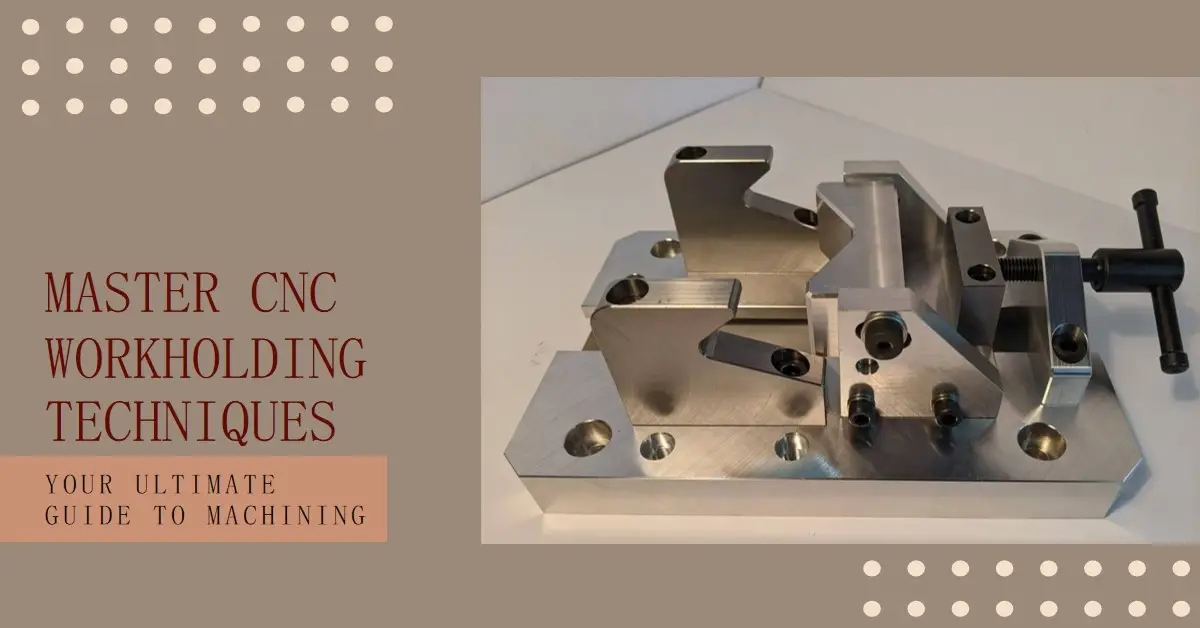
In the world of manufacturing, CNC workholding is a term that refers to the practice of securing a workpiece against the forces generated during machining operations. It is a crucial aspect of the machining process as it directly impacts the quality, accuracy, and efficiency of the finished product. In CNC machining, workholding involves using various devices and methods to hold the workpiece in a fixed position and orientation while it is being machined. Proper workholding setup ensures that the workpiece does not move or deform during the machining process, resulting in precise and consistent parts.
This article provides a comprehensive guide to workholding, covering different methods, setups, solutions, and considerations.
What is Workholding in Machining?
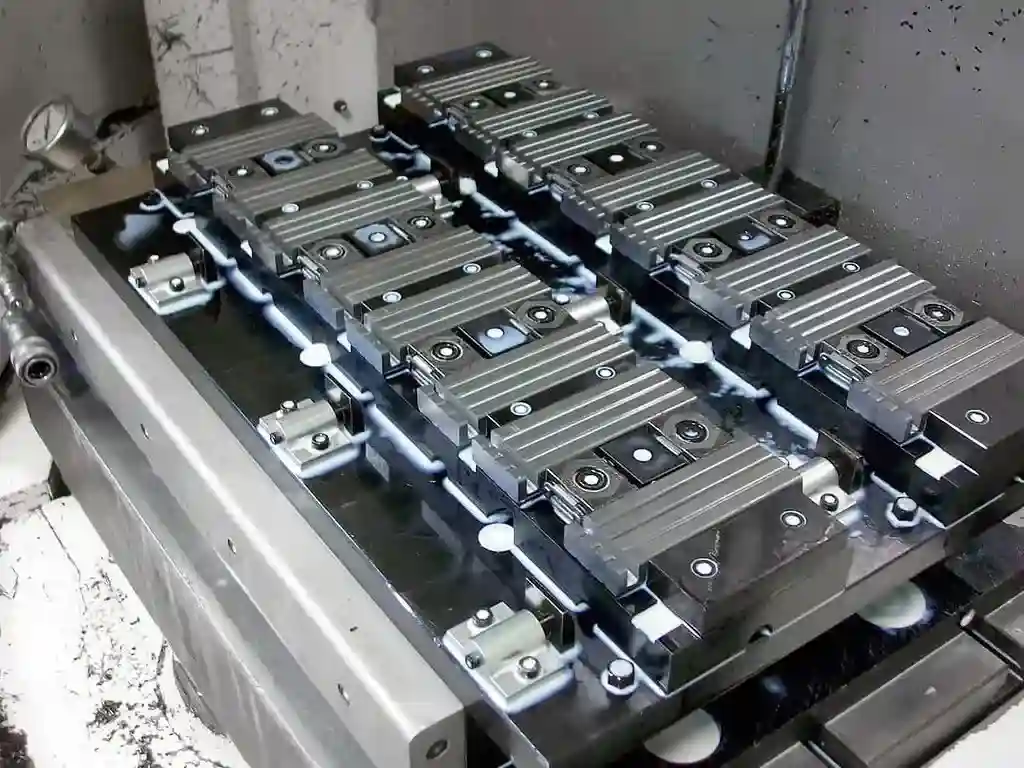
CNC Workholding
Workholding is a fundamental aspect of CNC machining that involves securing a workpiece in a fixed position and orientation during the machining process. It encompasses a variety of methods and devices used to hold, clamp, or fixture a workpiece, preventing movement or deformation during machining operations. The ultimate goal of workholding is to maintain the workpiece’s stability, orientation, and position to ensure that the finished product is accurate, precise, and consistent.
Securing the workpiece is of utmost importance as any movement or deformation can lead to inaccuracies, inconsistencies, or even damage to the workpiece or the cutting tool. It’s important to note that workholding is not a one-size-fits-all approach. Different workpieces, materials, and machining operations require different workholding methods and devices. Therefore, selecting the appropriate workholding method and device is crucial to the success of the machining operation.
CNC workholding in machining involves the following key elements:
- Clamping Force: It is the force applied to the workpiece to hold it in place during machining operations. The force applied to the workpiece during machining must be optimized based on the material’s hardness, machining operation, and the risk of deformation. Insufficient clamping force can lead to workpiece movement, while excessive force can cause distortion or damage to both the workpiece and the workholding device.
- Support: Refers to the mechanisms or devices that prevent deflection or bending of the workpiece during machining. This could include locators, rests, or pads that stabilize the workpiece while the clamping force holds it securely in position. Support can be provided using various devices, such as supports, rests, or fixtures.
- Location: It refers to the positioning of the workpiece in the workholding device. Proper location ensures that the workpiece is correctly oriented and aligned with the cutting tool and the CNC machine’s coordinate system.
- Stability: It refers to the stability of the workpiece during machining operations. Proper stability ensures that the workpiece does not vibrate, move, or deform during machining.
What Are the Importance’s of Workholding?
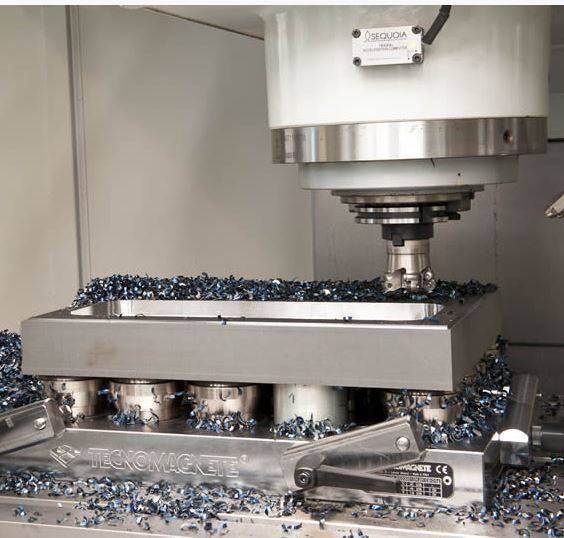
Workholding in CNC mill
Workholding is one of the most critical aspects of CNC machining and manufacturing processes in general. It is the method used to secure the workpiece in place while machiningit is being machined. The importance of CNC workholding cannot be overstated, as it directly impacts the quality of the finished product, the efficiency of the machining process, and the safety of the operation. Below are some of the key reasons why workholding is so important:
1. Accuracy and Precision
Proper CNC mill workholding solutions ensure that the workpiece is held securely in place and does not move during the machining process. This is crucial for achieving high levels of accuracy and precision in the finished product. Any movement of the workpiece during machining can lead to inaccuracies and inconsistencies in the final product. Moreover, the workpiece needs to be aligned correctly with the cutting tool and the CNC machine’s coordinate system. Proper workholding ensures correct alignment and orientation of the workpiece, which is essential for achieving the desired dimensions and tolerances in the finished product.
2. Consistency and Repeatability
In mass production, it is essential to produce parts consistently and repeatably. Proper workholding ensures that each workpiece is held in the same position and orientation during machining. This ensures that each part is machined consistently and repeatably, which is crucial for maintaining quality control standards and meeting customer specifications.
3. Efficiency and Productivity
Proper workholding allows for more aggressive machining parameters, such as higher feed rates and deeper cuts, which can lead to shorter cycle times and increased productivity. Moreover, proper workholding reduces the need for secondary operations and manual adjustments, which can further increase efficiency and productivity.
4. Tool Life
Proper workholding ensures that the cutting forces are evenly distributed across the workpiece and the cutting tool. This helps in minimizing vibrations and reducing tool chatter, which can lead to premature tool wear and breakage. Moreover, proper workholding ensures that the cutting tool is correctly aligned with the workpiece, which is essential for maximizing tool life and achieving optimal cutting performance.
5. Safety
Proper workholding ensures that the workpiece is securely clamped and does not move during machining. This is crucial for ensuring the safety of the operator and preventing accidents and injuries. Any movement of the workpiece during machining can lead to catastrophic consequences, such as damage to the machine, the cutting tool, or the workpiece itself.
Different Types of Workholding Devices
CNC workholding solutions are essential tools used in CNC machining and other manufacturing processes to hold, clamp, or fixture a workpiece securely in place during machining operations.
There are various types of CNC workholding fixtures available, each designed for specific workpieces, materials, and machining operations. Some of the most common types of workholding devices are as follows:
- Vises
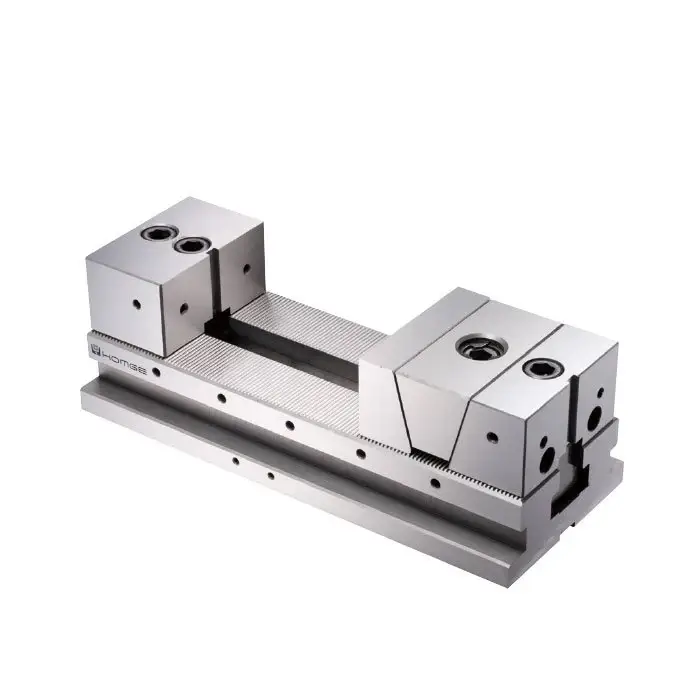
CNC Compect Vise
Vises are one of the most common workholding tools devices used in CNC machining. They consist of two jaws, one fixed and one movable, that clamp the workpiece securely in place. There are different types of vises available, such as bench vises, machine vises, and self-centering vises, each designed for specific applications.
- Chucks
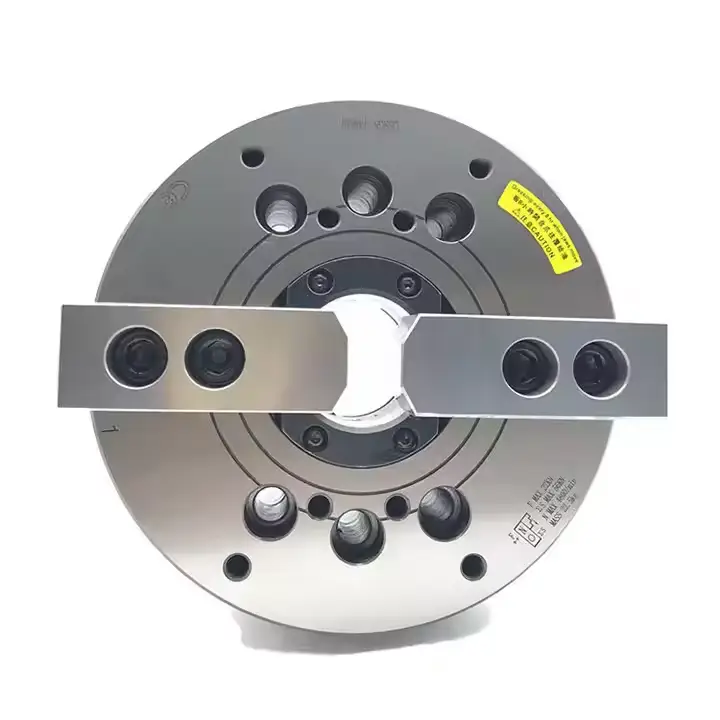
Lathe Chuck
Chucks are used to hold round or cylindrical workpieces securely in place during machining operations. They consist of jaws that grip the workpiece from the outside or the inside. There are different types of chucks available, such as three-jaw chucks, four-jaw chucks, and collet chucks, each designed for specific applications.
- Clamps
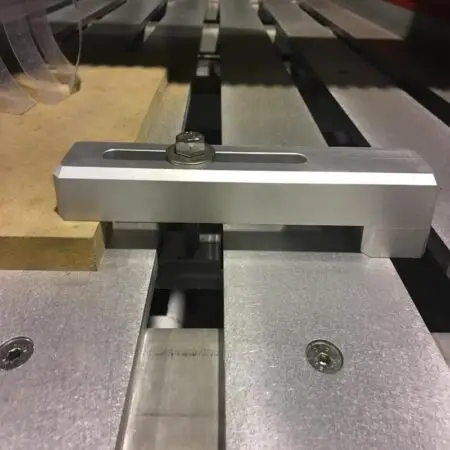
CNC Mechanical Clamping System
Clamps are used to hold the workpiece securely by applying force to specific areas, such as edges or surfaces, and can be adjusted to provide varying degrees of pressure. There are different types of clamps available, such as strap clamps, edge clamps, and toggle clamps, each designed for specific applications.
- Fixtures

CNC Fixture
Fixtures are workholding devices designed to securely hold a workpiece in place, often aligned and oriented for specific machining operations. They can be either custom-made or standardized for a variety of workpieces. They are used to hold the workpiece securely in place and correctly aligned and oriented during machining operations. Fixtures can be designed for a wide range of applications, such as milling, turning, grinding, and welding.
- Jigs
Jigs are similar to fixtures, but they also guide the cutting tool during machining operations. They are used to hold the workpiece securely in place and correctly aligned and oriented, while also guiding the cutting tool along a predefined path. Jigs can be designed for a wide range of applications, such as drilling, boring, and reaming.
- Collets
Collets are used to hold small or thin workpieces securely in place during machining operations. They consist of a tapered outer shell and a set of slits that allow the collet to contract and grip the workpiece securely. Collets are commonly used in milling machines and lathes.
- Mandrels
Mandrels are used to hold round or cylindrical workpieces securely in place from the inside during machining operations. They consist of a shaft that is inserted into the workpiece and expanded to grip it securely from the inside. Mandrels are commonly used in turning, grinding, and honing operations.
- Pallets
Pallets are used in automated machining environments to hold multiple workpieces securely in place. These are often part of a fixture system that allows for the simultaneous machining of several parts, improving efficiency in high-volume operations. They consist of a flat surface with locating and clamping features that allow multiple workpieces to be held in a fixed position and orientation. Pallets are commonly used in milling, drilling, and tapping operations.
Workholding Setup: What Are the Steps?
The setup of CNC workholding systems is a critical aspect of the machining process. It involves selecting the appropriate workholding device and configuring it properly to secure the workpiece during machining operations. A proper workholding setup ensures that the workpiece is held securely, correctly aligned, and oriented to achieve the desired machining accuracy and precision.
Step 1: Selection of Workholding Device
The first step in the workholding setup process is selecting the appropriate CNC workholding fixtures for the specific machining operation. The selection depends on various factors, including the size and shape of the workpiece, the machining operation to be performed, and the required level of precision.

Vise and accessories
Vises are commonly used for holding workpieces of various geometries, including flat, round, or irregular surfaces, while chucks are used for holding round or cylindrical workpieces. Clamps are suitable for workpieces that require pressure on their surfaces, whereas fixtures and jigs are custom-made for specific workpieces or operations.
Step 2: Alignment and Orientation
After selecting the appropriate workholding device, the next step is to align and orient the workpiece correctly. This involves positioning the workpiece in the workholding device so that its machined surfaces are aligned with the machine tool’s axes. Proper alignment and orientation are crucial for achieving the desired machining accuracy and preventing tool deflection or workpiece deformation.
Step 3: Clamping
Clamping is the process of securing the workpiece in the workholding device. It is essential to apply the correct clamping force to hold the workpiece securely without causing deformation. Excessive clamping force can lead to workpiece deformation, while insufficient clamping force can result in the workpiece moving during machining. Therefore, it is crucial to determine the appropriate clamping force required for the specific machining operation.
Step 4: Verification
After clamping the workpiece, it is essential to verify that it is correctly aligned, oriented, and securely held in the workholding device. This can be done using various methods, such as dial indicators, edge finders, or probing systems. Verification ensures that the workpiece is correctly set up and ready for machining.
Step 5: Adjustment
During the machining process, it may be necessary to make adjustments to the workholding setup. For example, the workpiece may need to be repositioned or reoriented to access different surfaces or features. It is essential to make these adjustments carefully to maintain the desired machining accuracy and prevent damage to the workpiece or machine tool.
Factors to Consider for Proper Workholding
The proper workholding involves selecting the appropriate device, positioning the workpiece correctly, and securing it firmly. The following are some key considerations for workholding setup:
- Workpiece Geometry: The geometry of the workpiece plays a significant role in selecting the appropriate CNC workholding fixtures. For example, vises are suitable for holding rectangular or square workpieces, while chucks are used for holding round or cylindrical workpieces.
- Machining Forces: The forces generated during the machining process must be considered when setting up the workholding device. It is essential to ensure that the workholding device can withstand the machining forces and secure the workpiece firmly.
- Accessibility: It is essential to ensure that the workholding device does not obstruct the cutting tool or interfere with the machining operations. Proper accessibility is crucial for achieving accurate and consistent results.
Read More: Affordable CNC Milling Services | Low Cost, On Time, To Specification
What Are the Different Workholding Methods?
The workholding method chosen can directly impact the accuracy, precision, and overall success of the machining operation. Different workholding methods are suitable for different applications, and the choice of method depends on various factors such as the size and shape of the workpiece, the machining operation being performed, and the required level of precision. Here are some common workholding methods and their applications.
- Mechanical Clamping
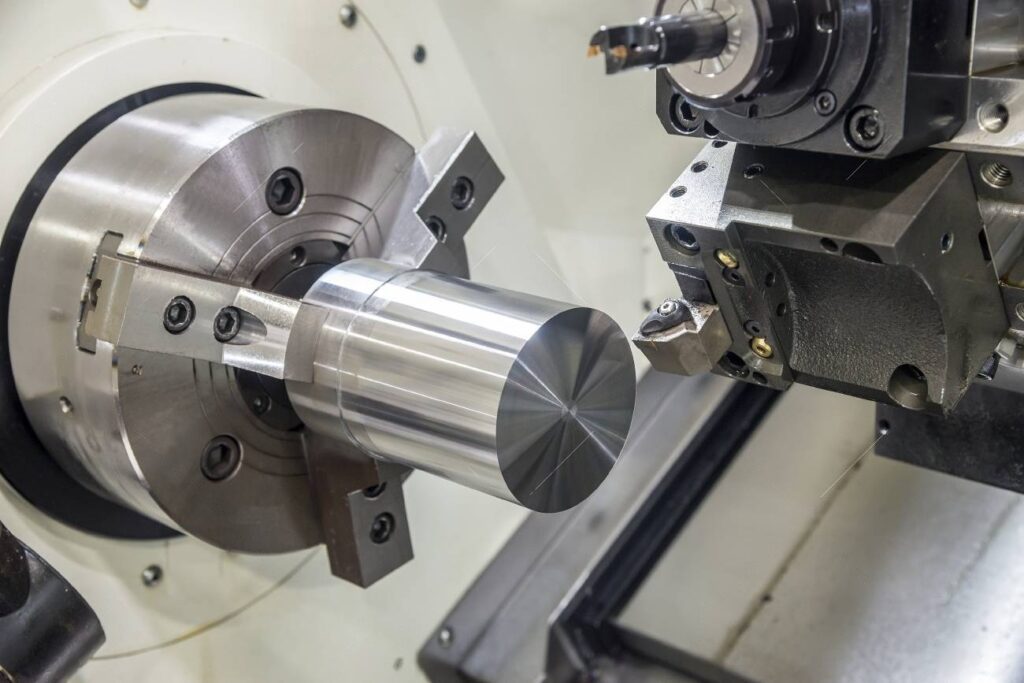
Mechanical clamping example
Mechanical clamping is the most common CNC mill workholding method used in machining operations. It involves using mechanical devices such as vises, chucks, and clamps to secure the workpiece in place. Mechanical clamping is suitable for a wide range of applications and workpiece sizes and shapes. However, it is essential to apply the correct clamping force to hold the workpiece securely without causing deformation.
- Magnetic Workholding
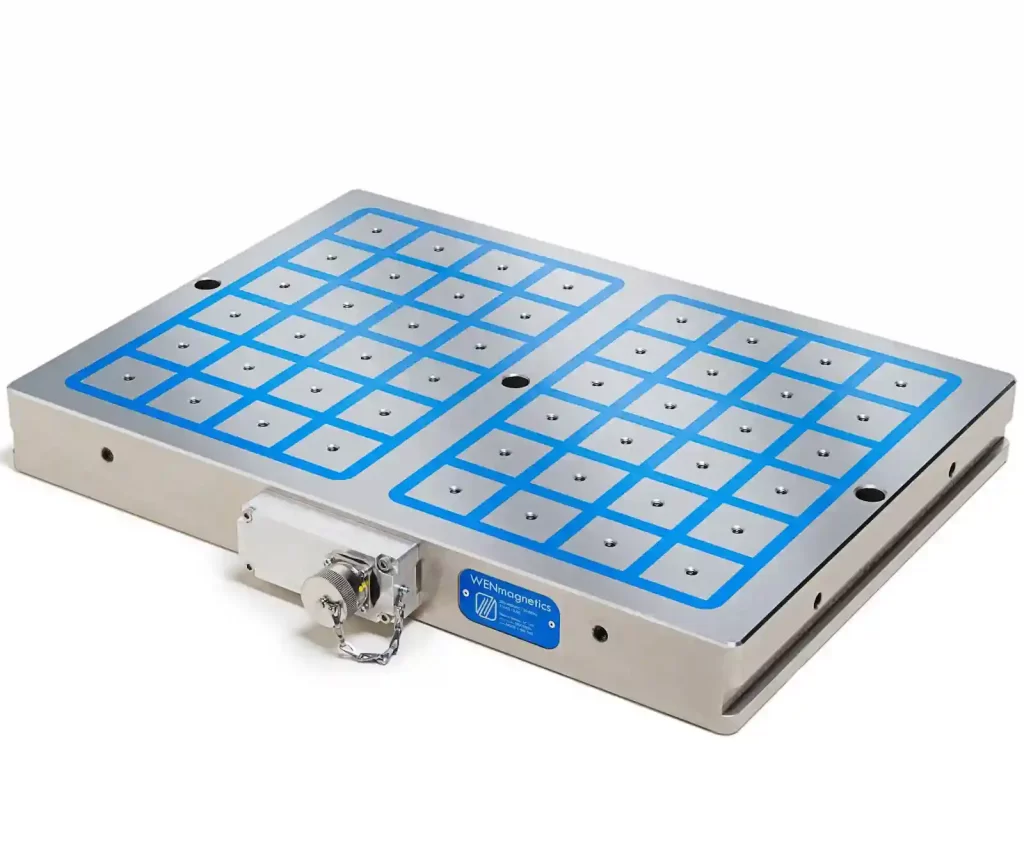
Magnetic Workholding
Magnetic workholding involves using magnetic chucks or plates to secure the workpiece in place, primarily for ferrous materials. The magnetic force generated by the chuck or plate ensures uniform clamping force across the workpiece surface.
Magnetic chucks are commonly used in milling and surface grinding operations, though they may not offer the same precision required in fine grinding applications. It offers quick setup times and provides uniform clamping force across the workpiece surface.
- Vacuum Workholding
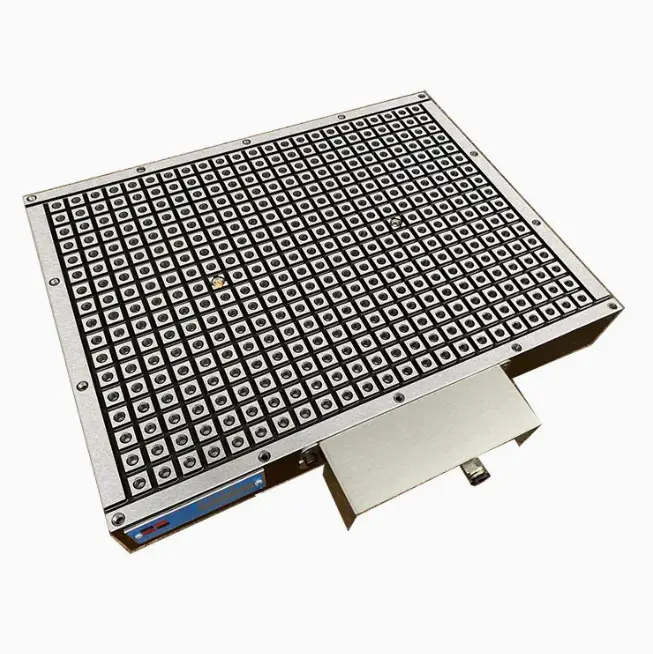
Vacuum Workholding for Small Parts
Vacuum workholding uses vacuum chucks or tables to hold workpieces securely in place. This method is particularly effective for flat or thin workpieces, especially those made of non-ferrous or non-magnetic materials. It provides uniform clamping force across the surface, making it ideal for applications like milling, drilling, and grinding. However, vacuum workholding is less effective for heavy or thick workpieces.
- Hydraulic Clamping
Hydraulic clamping involves using hydraulic clamps or vises to secure the workpiece in place. The workpiece is held in place by the hydraulic pressure generated by the clamp or vise.
Hydraulic clamping is suitable for a wide range of applications and workpiece sizes and shapes. It provides uniform clamping force across the workpiece surface and offers quick setup times.
- Pneumatic Clamping
Pneumatic clamping uses air pressure to secure the workpiece in place. This system is particularly beneficial for high-speed, high-volume applications where rapid loading and unloading are needed. Pneumatic workholding is suitable for a wide range of workpiece sizes and shapes, though it might not provide the clamping force required for heavier or more rigid materials.
- Custom Fixturing
Custom Fixturing involves designing and manufacturing tailored fixtures or jigs to hold the workpiece securely during machining. It is particularly useful for complex, irregular workpieces, high-volume production, or operations requiring high precision, where standard workholding devices may not provide the necessary stability or efficiency.
Table: Summary of workholding methods
| Workholding Method | Description | Suitable For |
|---|---|---|
| Mechanical Clamping | Using mechanical devices such as vises, chucks, and clamps to secure the workpiece. | A wide range of applications and workpiece sizes and shapes. |
| Magnetic Workholding | Using magnetic chucks or plates to secure the workpiece. | Ferrous materials, surface grinding operations. |
| Vacuum Workholding | Using vacuum chucks or tables to secure the workpiece. | Non-ferrous and non-magnetic materials, milling and grinding operations. |
| Hydraulic Clamping | Using hydraulic clamps or vises to secure the workpiece. | A wide range of applications and workpiece sizes and shapes. |
| Pneumatic Clamping | Using pneumatic clamps or vises to secure the workpiece. | A wide range of applications and workpiece sizes and shapes. |
| Custom Fixturing | Designing and manufacturing custom fixtures or jigs to hold the workpiece. | Complex workpieces with irregular shapes or surfaces. |
What Are the Workholding Considerations?
In the world of manufacturing, workholding is a crucial consideration in the machining process. It involves securing the workpiece in place during operations such as milling, drilling, grinding, and turning. Effective workholding ensures the workpiece does not move or deform during machining, allowing for precise and accurate results. There are several factors to consider when selecting the right workholding solution for a particular application.
Table: Workholding considerations
| Consideration | Description | Implication |
|---|---|---|
| Workpiece Material | The hardness or softness of the workpiece material. | Soft materials may deform under pressure, requiring gentler clamping forces. Hard materials may require stronger clamping forces. |
| Workpiece Geometry | The shape and size of the workpiece. | Complex or irregular shapes may require custom fixtures or jigs. Simpler, more regular shapes may be suitable for standard clamps or vises. |
| Machining Operation | The type of machining operation being performed. | The workholding solution must be able to withstand the forces exerted during the machining operation. |
| Tolerance and Surface Finish Requirements | The required tolerances and surface finish of the final product. | The workholding solution must ensure no movement of the workpiece during machining and must not leave marks on the workpiece. |
| Setup Time | The time it takes to set up the workholding solution. | Minimizing setup time is crucial in high-volume production to maximize efficiency and productivity. |
| Flexibility | The ability to adapt the workholding solution to different workpieces and machining operations. | A flexible workholding solution can save time and costs by reducing the need for multiple setups and workholding devices. |
Summing Up
Workholding is a critical aspect of the CNC machining process as it directly impacts the quality, accuracy, and efficiency of the finished product. Proper workholding ensures that the workpiece does not move or deform during the machining process, resulting in precise and consistent parts. Manufacturers must consider various factors, such as workpiece geometry, material, size, and weight, machining operations, and cost, when selecting the appropriate workholding method and device. By understanding the principles of workholding and implementing effective workholding strategies, manufacturers can optimize their CNC machining operations and produce high-quality parts. At Prolean, we provide comprehensive CNC machining services to our clients. We understand the importance of proper workholding and implement effective strategies to ensure the highest quality, accuracy, and efficiency in our machining operations. Our team of skilled professionals and state-of-the-art CNC machines allows us to handle a wide range of workpiece geometries, materials, and sizes. Contact us today to learn more about our CNC machining services and how we can help you with your manufacturing needs.
FAQs
What is workholding in CNC machining?
Workholding in CNC machining refers to the practice of securing a workpiece against the forces generated during machining operations. It involves using various devices and methods to hold the workpiece in a fixed position and orientation while it is being machined.
Why is workholding important?
Proper workholding is crucial for achieving accurate, precise, and consistent results in CNC machining. It helps in minimizing vibrations, reducing deformations, and ensuring that the machining forces are evenly distributed across the workpiece.
What are some common workholding devices?
Some common workholding devices used in CNC machining include vises, chucks, clamps, and fixtures.
What are some key considerations for workholding?
Some key considerations for workholding include workpiece geometry, material, size, and weight, machining operations, and cost.
What are some workholding solutions?
Some workholding solutions include modular workholding, custom workholding, mechanical workholding, vacuum workholding, and magnetic workholding.




Das Arbeiten mit der CNC-Fräse kann gefährlich werden. Die richtige Werkstückspannung sollte sichergestellt sein. Wichtig ist, dass sich das Werkstück während der Bearbeitung nicht bewegt, ansonsten könnte es geschleudert werden.